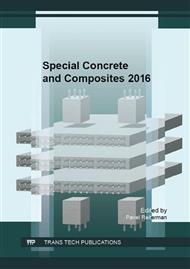[1]
Figuli, L., Magura, M., Kavický, V., Jangl, Š. Application of recyclable materials for an increase in building safety against the explosion of an improvised explosive device. Advanced Materials Research Vol. 1001 (2014).
DOI: 10.4028/www.scientific.net/amr.1001.447
Google Scholar
[2]
Figuli, L., Papan, D. Single Degree of Freedom Analysis of Steel Beams under Blast Loading. Applied Mechanics and Materials Vol. 617 (2014) pp.92-95. Trans Tech Publications, Switzerland 2014. doi: 10. 4028/www. scientific. net/AMM. 617. 92.
DOI: 10.4028/www.scientific.net/amm.617.92
Google Scholar
[3]
Štoller, J,. Dvořák, P. Field Tests of High Performance Fiber Reinforced Concrete Slabs: Impact of Contact and Distant Explosions. In: ICMT 2015 INTERNATIONAL CONFERENCE ON MILITARY TECHNOLOGIES. Brno: University of Defence, 2015, pp.235-239.
DOI: 10.1109/miltechs.2015.7153679
Google Scholar
[4]
Štoller, J., Zezulová, E. Testing of critical infrastructure protection against the distant trinitrotoluene blast. In: TRANSPORT MEANS 2015, PROCEEDINGS OF THE 19th INTERNATIONAL SCIENTIFIC CONFERENCE. Kaunas, Lithuania: Kaunas University of Technology, 2015, pp.505-508.
Google Scholar
[5]
Jiříček, P., Foglar, M. The influence of the different bridge pier reinforcement arrangements on the performance under vehicle impact. (2014).
DOI: 10.1201/b17063-111
Google Scholar
[6]
Foglar, M., Hájek, M., Kovář, M., Štoller, J. Blast performance of RC panels with waste steel fibers. Construction and Building Materials, 2015, vol. 94, art. No. 6897, 30 September 2015, pp.536-546.
DOI: 10.1016/j.conbuildmat.2015.07.082
Google Scholar
[7]
Tadepalli, P., Mo, Y., Hsu, T., Vogel, J. Mechanical Properties of Steel Fiber Reinforced Concrete Beams, 2009 Structures Congress, ASCE, Austin, TX, 2009. p.1039–1048.
DOI: 10.1061/41031(341)115
Google Scholar
[8]
Köksal, F., Şahin, Y., Gencel, O., Yiğit, İ. Fracture energy-based optimisation of steel fibre reinforced concretes, Eng. Fract. Mech. 107 (2013) 29–37. ISSN 001f3-7944.
DOI: 10.1016/j.engfracmech.2013.04.018
Google Scholar
[9]
Kovář, M. Foglar, M., Hájek, R. The blast performance of real-scale reinforced concrete specimens with varying fiber types and content. (2014) WIT Transactions on the Built Environment, 141, pp.159-169. DOI: 10. 2495/SUSI140141.
DOI: 10.2495/susi140141
Google Scholar
[10]
STANAG 2280 - MC ENGR (Edition 1) (Ratification draft 1) – Design Threat Levels and Handover Procedures for Temporary Protective Structures. NATO Standardization Agency, June (2007).
Google Scholar
[11]
STANAG 4569 - Protection Levels for Occupants of Logistic and Light Armored Vehicles. NATO Standardization Agency, December (2012).
Google Scholar
[12]
Štoller, J., Dvořák, P. Non-Destructive Testing of Full-Scale Slabs Before and after Blast Load. In: Proceedings of 19th International Scientific Conference Transport Means. Kaunas, Lithuania: Kaunas University of Technology, 2015, pp.298-301.
Google Scholar
[13]
Zezulová, E., Štoller, J. Non-destructive Testing of Materials Used for Protective Structures Built from High Performance Fibre Reinforced Concrete after the Contact Explosion Loading. In: 11th European Conference on Non-Destructive Testing (ECNDT 2014). Brno: Brno University of Technology FME, 2014, pp.1-12.
Google Scholar


